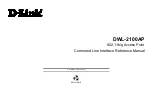
2
Connecting The DI-524 Wireless
Router To Your Network
A.
Receptor for
Power Adapter
.
Reset Button
Pressing this button restores the Router to its original
factory default settings.
A.
First, connect the power adapter to the
receptor
at the back panel of the
DI-524 and then plug the other end of the power adapter to a wall outlet or power
strip. The Power LED lights up indicating proper operation.
B.
1. Power off your Cable or DSL modem; devices that do not have a on/off switch and
will require you to unplug the power adapter. Now, the DI-524 should be powered on
and the Cable / DSL modem should be turned off.
Cable / DSL modem (
Power Off
) – DI-524 (
Power On
)
2. Connect an Ethernet cable to the Ethernet jack located on the Cable / DSL
modem. After the Ethernet cable is securely connected, power on the Cable / DSL
modem by turning on the unit or plugging in the power adapter.
Cable / DSL modem (
Power On
) – DI-524 (
Power On
)
3. Insert the other end of the Ethernet cable to the WAN PORT on the back panel of
the DI-524. The WAN LED light will illuminate to indicate proper connection. If the
WAN LED is not illuminated, please go back to step B1 and repeat the steps.
C.
Insert an Ethernet cable to
LAN Port 1
on the back panel of the DI-524 and an
available Ethernet port on the network adapter in the computer you are using to
configure the DI-524. The LED light for LAN Port 1 illuminates to indicate proper
connection. (Note: The LAN Ports on the DI-524 are Auto-MDI/MDI-X. Meaning you
can use a straight-through or crossover-Ethernet cable in the LAN Ports.)
D.
Computers equipped with 802.11g wireless adapters will be able to connect to the
DI-524. The DWL-G630
Air
Plus G Wireless Cardbus Adapter and the DWL-G510
Air
Plus G Wireless PCI Adapter will be able to connect out of the box with the router
using their default wireless settings.
B.
WAN PORT
This is for the connection
of an Ethernet cable to the
Cable or DSL modem.
D.
Antenna
Used to
wirelessly
connect to
802.11g or
802.11b
adapters.
C.
LAN PORTS
These are the
connections for Ethernet
cables to Ethernet
enabled computers.



































